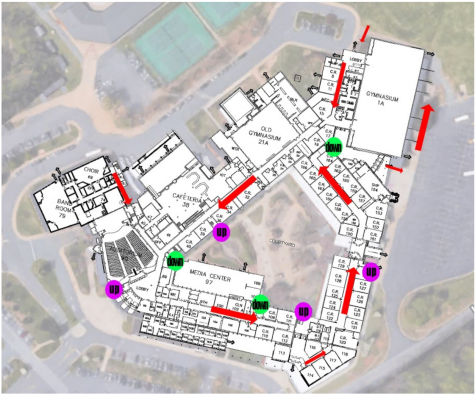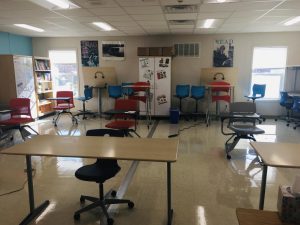Starting the Year 8 Months Later
What school will look like for those returning for hybrid instruction
March 14, 2021
For the first time this year, students and staff are leaving the comfort of their couches, masking up, and braving the halls as we make the transition to Stage Four learning.
“I don’t care how great zoom tech becomes,” head principal Darah Bonham said, “it can never replace the in-person learning environment.”
After months of preparation, administrators, teachers, custodial staff, and cafeteria staff are excited to welcome masked students back into the building.
On top of normal duties, the custodial staff will be increasing sanitation to “high touch” areas as well as disinfecting classrooms every night, according to lead custodian Glynn Baker. Students will be asked to do their part by maintaining six feet distances at all times and wearing a mask properly throughout the day.
Morning routines will be vastly different. Doors will not open until 9:15 and every person will be temperature checked before entering the building. Bus riders will be released in waves to implement social distancing rules. If a student has no temperature and no exposure to Covid-19, they will walk directly to their first-period classroom.
First period teachers will take students’ lunch orders. Lunch is free for all students; they just have to decide if they want the daily hot lunch offering or a peanut butter and jelly sandwich, according to cafeteria manager Jenn Czarnecki.
Once class begins, it is up to teachers to decide how they will effectively educate both virtual and in-person students.
MESA math teacher Bill Daly dubbed his virtual and in-person students his “zoomies and roomies.” The curriculum he taught first semester students will remain constant through the second semester; however, Daly acknowledged adaptations he would have to make to test procedure and answering questions in class.
Daly’s plan for equal and controlled test-taking will be implementing what he likes to call “quick checks.” These will be short-timed quizzes or singular questions that both roomies and zoomies will complete at the same time. “I want to make the learning process as fair as possible,” Daly said. He believes that these quick checks will provide him with information on what kids know and leave less time for dishonesty.
“I am hoping that the people who are not engaging in class decide to go hybrid so that I can better teach them,” Daly said. “I am excited to have people respond to my questions in a classroom so that I am not stuck responding to myself.”
Although at least 700 students will have all four teachers at the school, about 100 will have one block where a teacher may be teaching from home. In this scenario, students will be sent to a space to continue virtual learning such as the library or cafeteria. The auditorium will be reserved for unexpected teacher absences to avoid the use of subs and keep track of all students in the building.


During class changes, students will follow a one-direction hallway and stairwell system continuously moving counterclockwise.
Students’ second block teachers will be responsible for their lunch period. During staggered times, the entire class will walk down to a station for students who are choosing school lunch. Upon returning to the classroom, students will have 30 minutes to eat.
“Everything is going to feel very controlled,” Bonham said. Seniors will not be able to leave campus for lunch.
As the school day ends, everyone will go their separate ways. If any student is participating in an extracurricular activity they are to report directly there.
“Coming back will give students a chance to feel they are part of the high school community,” Bonham said. He hopes that Stage Four will, “bring back a sense of “belonging and social life.”
“Although it is different from last year,” Bonham said, “it is so uplifting to see students in the building again.”
March 10 and 11 are the first days back to school for ninth graders. The Monday and Tuesday before that will be asynchronous, allowing for teachers to prep for the incoming students. The official hybrid school schedule and start date of Stage Four will be March 15.



